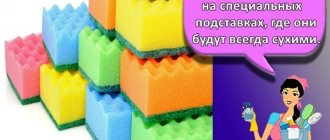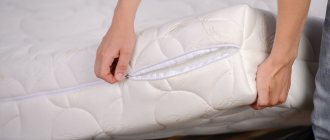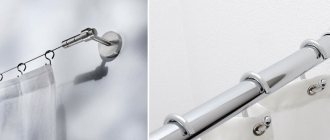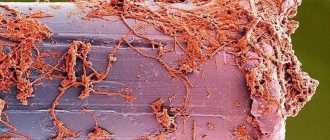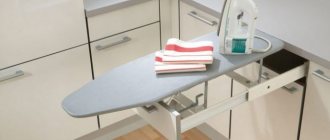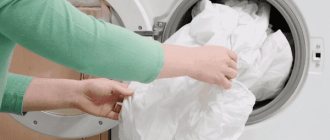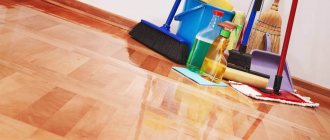Brushings
with natural pig or horse bristles will be useful for straightening and beautifully styling curly hair.
A round brush can handle strands of any length; when heated with a hairdryer, it acts as a straightening iron. To add root volume or lightly curl the ends, you will need a small comb, but straightening strands is more convenient with a more massive option. If the teeth of the brush are bent and pointing in different directions, do not rush to throw away your favorite assistant: a high-quality comb can be doused with boiling water, and it will restore the lost functionality.
"Fish bone"
, or
a skeleton comb
, will also help add volume and prevent overheating when using a hair dryer. This is a brush with widely spaced teeth, which are rigidly attached to a base pierced with air holes. “Fish bone” is convenient when styling with a hairdryer; with its help you will be able to lift your hair at the roots, stretch, straighten your curls, and make a smooth styling.
With semicircular brush
you can handle styling curls, bangs and the ends of a multi-layered haircut.
Flat combs
They are often used for haircuts, trimming ends, backcombing, and are also convenient for evenly applying paints, oils, masks and styling products. Flat, fine-tooth combs are useful if you have medium-length or short hair, while a wide-toothed accessory can comb and smooth thick, long hair. One of the varieties of flat combs is a comb, which is convenient for creating a parting and separating strands.
Which comb is best for detangling hair?
Comb
detangler
Tangle
Teezer
Ideal for detangling curly, thick and wavy hair
. It has long and short teeth alternating in a checkerboard pattern. Long ones are good at untangling knots and tangles and separating one hair from another.
Interesting materials:
When to plant peonies? When to plant ranunculus flowers? When to plant hazel grouse flowers? When to plant thujas in the ground? When to plant thuja in the Leningrad region? When to plant thuja in the ground? When to plant thuja in open ground? When to plant pumpkin seedlings in 2022? When to plant dill in 2022? When to plant remontant strawberry tendrils?
General rules for caring for combs
The comb can perform its function for several years in a row until it becomes completely unusable. At the same time, in some families there are common combs for all household members.
This is fundamentally wrong. The comb is intended for individual use, like many hygiene items. You shouldn’t “help out” forgetful friends by giving up your brushing . It retains the remains of biomaterial, which, transmitted through microparticles, can provoke the occurrence of skin itching, pustular diseases, lichen, pediculosis, staphylococcal infections, scabies, and many other diseases.
Get yourself an individual comb (or several) and use only it, without giving it to anyone or claiming someone else’s. At the same time, it is important to follow several general care rules that will help keep her and your hair clean:
- after combing, remove all hairs stuck to the teeth;
- wash it more often, at least once a week, using liquid soap and an old toothbrush;
- sanitary measures can be replaced by alcohol treatment.
Important! In Rus', it was believed that combing one’s hair with someone else’s comb meant taking upon oneself all the troubles and worries of the owner of the comb. Our unenlightened ancestors did the very right thing, protecting themselves from trichological problems.
How often do you need to change hygiene products?
Over time, the comb becomes a collection of bacteria and microorganisms, with which the hair quickly becomes dirty and can even get sick. Unfortunately, soap or alcohol cannot guarantee complete cleaning of the surface . The teeth break, and plastic balls fall off from the ends of the brush, protecting the scalp from microtraumas. All this leads to the replacement of hygiene items. Trichologists, specialists in hair health, urge you to buy new combs at least 1-2 times a year. Of course, the material used to make the comb plays an important role in this.
Mistake No. 9. You believe that long brushing will make your hair grow better.
There are still people who firmly believe that the longer you comb your hair, the better it will grow. This is not true; there is no relationship between hair growth and the duration of combing.
Not the first freshness. 8 Mistakes That Make Your Hair Look Dirty Read more
Cleaning a plastic comb
Plastic combs are the most popular; they are inexpensive and practical. There are several varieties of such products. Massage brushes with plastic teeth have a soft rubber base. They should not be soaked in water; it is not recommended to use hot water when washing. The product is first cleaned of hair and then washed without immersion.
Regular plastic combs can be immersed in water with shampoo, dish soap, or soap. After 10 minutes, the dirt will become soft and can be easily removed from the comb. It will be enough to just wipe the product. You can use an old toothbrush to thoroughly clean the space between the teeth.
Bed sheets
FoxTime talks about how often we need to change bed linen, toothbrushes and other household items that we use every day. A timely change of some household items will not only add coziness and comfort to your life, but will also preserve your health.
Photo / Taryn Elliott / pexels.com
It is very difficult to notice dust on bed linen with the naked eye - unless you fluff up a pillow or blanket in direct sunlight and see small pellets slowly falling onto the linen. Barely noticeable, they can be a dangerous enemy to your health. Dust particles contain bacteria, viruses and microscopic bed mites. Constant contact with them threatens to deteriorate the body’s immune functions, develop allergies and irritate the mucous membranes.
In addition to dust, dead body cells also settle on bed linen, including hair, sweat and other secretions, which are no less dangerous to health. Recommended frequency of changing bed linen: 1 time per week in the warm season and 2 times per month in the cold season.
It’s more difficult with pillowcases: they need to be changed more often than other linens. This is especially important if you have contracted a viral disease: viruses also settle on pillows. It is also recommended to use bleach during washing, and the washing itself should be done at a temperature of at least 50 degrees - this way you will get rid of more harmful microorganisms.
Photo / Ketut Subiyanto / pexels.com
Bed bugs and other harmful organisms don't just settle on bedding. One of their habitats can be pillows, blankets and even mattresses. As a rule, simple washing or dry cleaning will not help get rid of them - blankets, mattresses and pillows must be replaced.
The replacement schedule for each part of your bedding is individual. So, a blanket should be changed once every ten years, a mattress - once every six to seven years, and pillows - at least once every four years. However, it is worth paying attention not only to their timely replacement, but also to their composition, since pillow fillers differ in their composition and, as a result, in their ability to become a distributor of allergens.
Down and wool fillers can be the most dangerous in this regard, so when purchasing pillows, opt for synthetics. It is enough to dry clean synthetic materials once every six months. If replacing a mattress may seem too wasteful, then you should take a closer look at buying a mattress topper - not only will it save money and delay the purchase of a new mattress, but it is also easy to wash.
Photo / Alleksana / pexels.com
Dentists unanimously declare that a toothbrush needs to be changed every three months, but most people treat this rule with disdain and change it only when all the bristles move in different directions. This approach is wrong - over time, the toothbrush becomes a home for harmful bacteria, and each subsequent brushing of the teeth with it becomes less and less effective.
Overall, the longevity of a toothbrush depends on both its quality and the condition of your teeth. The general rule for everyone is that the brush needs to be changed at least four times a year, that is, the already indicated every three months. Also, the toothbrush must be replaced with a new one after completing treatment for a viral or any other disease, since there is a high risk of re-infection.
If you forget the first time you used your toothbrush, pay attention to the color of its bristles. Nowadays, bright colors are often used in the design of toothbrushes: the longer you use them, the duller and more faded their color becomes. The brush can also be stored in a separate case, but you can only put it there when it is completely dry.
Photo / Polina Kovaleva / pexels.com
A washcloth allows you to remove dead skin particles from the body, which are a breeding ground for bacteria. One way or another, they remain on the washcloth itself - you cannot get rid of them with soap. At the same time, the material from which the washcloth is made does not matter: natural or synthetic; it needs to be changed every six months. A sponge for bathing - once a month.
Photo / Cottonbro / pexels.com
The most popular materials for making combs are plastic and wood. The timeline for replacing this unnoticed but important piece of personal care depends on what it's made of. So, wooden combs should be changed every three months. The fact is that cracks form at their ends over time, which can cause hair to become brittle. Similar damage can appear on plastic combs, but they can be changed less frequently - for example, once every four months. If you cannot find any cracks or chips on the ends of the comb, and your hair does not suffer from its use, then the comb can be changed once a year - to maintain personal hygiene.
Photo / Karolina Grabowska / pexels.com
For the face – every other day. Often, the source of acne and skin rashes can be failure to comply with basic hygiene standards. For those with problematic facial skin, it is advisable to wash the towel after each use or use disposable wipes.
For intimate hygiene - change after each use. For legs - change every 2-3 days, depending on the frequency of use and time of year (more often in summer, and less often in winter). For hands - change every 2-3 days. For the body – also every 2-3 days. It is important to dry bath towels thoroughly, as they are the densest and therefore take a long time to dry naturally.
As for kitchen and dish towels, they should be changed every day or at least every other day. Everything that comes into contact with food and tools for preparing it should be as clean as possible.
Photo preview / Andrea Piacquadio / pexels.com
Scalp type:
✔ If the scalp is oily, there are pustular formations, then natural materials will not be suitable. A comb with sparse teeth, made of plastic, is suitable, because... it will be handled well. If you choose a wooden comb, then with frequent processing it will crack and injure your hair.
Why a wide-toothed comb? For oily scalp, there should be a large distance between the teeth in order to stimulate the sebaceous gland less and thereby make the scalp less “oily.”
✔ For dry skin types or sensitive scalps, massage combs are perfect because... they massage the skin, and therefore stimulate the sebaceous gland so that it produces more sebum to nourish the skin.
Dependence of replacement period on comb material
To comb the head and dry hair, metal, plastic, wooden combs, massage brushes made of the same materials and natural bristles, as well as metal and plastic brushes are used.
The use of metal hygiene items can be longer due to the greater practicality and durability of the material, the preservation of its design features and, with proper care, easier cleaning of the teeth from keratinized skin particles. If nothing breaks or falls off, then the time of using a metal comb can be 1 year.
Wooden combs and hair brushes are more pleasant and useful. They perfectly massage the head, maintain the structure of the hair, lift it at the roots and increase the volume of the hairstyle. The same properties are inherent in massage combs made of natural bristles. They need to be changed as individual elements fail, but at least once a year.
Plastic combs are susceptible to the formation of microcracks, which negatively affects the condition and health of the hair and scalp. They are replaced every three to six months.
How to choose a ring?
Braids on a knitting machine
Natural bristle combs
Many people don’t know how to clean a natural bristle comb. These are products made from natural materials that provide excellent hair care. However, after about a couple of weeks, a lot of hair, oil, and skin particles remain on the brush. Such combs can be cleaned frequently; it is recommended to carry out the procedures in the following sequence:
- First you need to manually remove hair and large dirt;
- then you need to dissolve natural soap without silicone in water;
- To dissolve the fat, you should also add a few drops of ammonia;
- the brush is immersed in water with the bristles down, so it is recommended to use a small container for washing;
- cleaning is done with an old toothbrush;
- In order for the product to dry, you need to place it on a clean towel with the bristles down.
Regular dry cleaning of the brush is also recommended. Simply remove old hair between the bristles. By the way, this procedure can be carried out using a regular comb.
